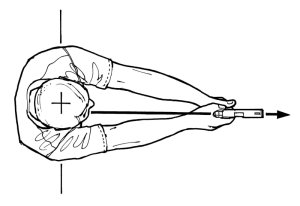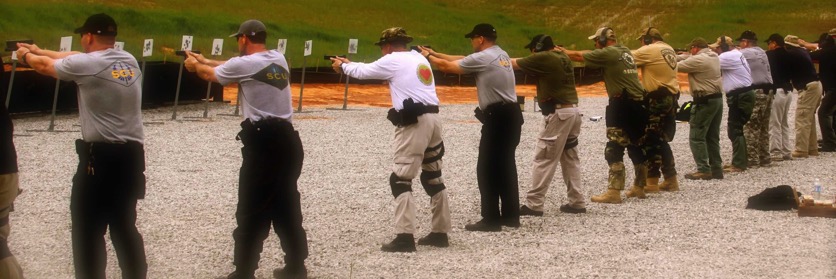Jason Bourne was wrong?
13/06/14 22:16 Filed in: shooting

Techniques, tactics or processes, well as equipment, should be studied, analyzed, and tweaked constantly. You ask three questions, whether in shooting, in business, or even mowing your grass - will it work, is it necessary, and can I do it under stress?
Federal weapons training up thru the early 1990’s initially taught shooting a Modified Weaver stance, where the shooting arm is straight and the support arm bent—the same way Jason Bourne shoots in the movies. When firing, told us to push forward with our shooting arm and pull back with the other, all while standing with our bodies turned at a 45-degree angle to our targets and our heads bent slightly to align the gun sight.
This push-pull concept was supposed to create a more stable shooting platform. The technique was soon replaced by the Modified Isosceles, which features both arms outstretched, the weapon gripped with pressure from both hands and no push-pull going on. It’s a much more natural and effective way to shoot, especially under stress.
Techniques like these, as well as equipment, are studied, analyzed, and tweaked constantly. You ask three questions of any tactic, technique, or process, whether in shooting, in business, or even mowing your grass.
1 - First, will it work? In other words, will the way I’m doing it get the job done?
2 - Second, is it necessary? In other words, is there a better, more efficient way to do it?
3 - Finally, can I do it under stress?
A negative answer to any of these questions means you toss that technique until you find a way to do it that leads to three yes answers. Will it work? Is it necessary? Can I do it under stress?

Here’s how you might apply it: People argued and even fought over which stance was better—the Jason Bourne way or the Modified Isosceles. Most of the debate came from guys who’d argue over whether professional wrestling was real and who’d never been shot at, nor shot at someone else. Regardless, passions on the subject ran high in the shooting world. To resolve it, apply the three questions.
The Weaver stance was created out of a desire to give the shooter a solid grip—the straight arm was supposed to replicate the stock of a rifle and the push-and-pull action was to help keep the gun stable. On top of that, people have been shooting people using the Weaver stance for years. So yes, it worked, and yes, and it could be done under stress. But was it necessary to do it that way? No.
Why? Weaver says you have to have the push-pull to steady the gun—to hit, in other words. Therefore, by default, that must mean that you can’t shoot with one hand, because there’s nothing pulling back. But you can shoot one-handed; it’s been done for ages. So no, the push-pull wasn’t necessary—meaning the Weaver failed this part of the analysis.
Another problem with the technique was that they wanted us to lower our heads to line up with the gun sights. That’s a waste of critical microseconds—you bring the gun to your face, not your face to the gun. That eliminates one more moving part in the shooting equation. So that part of the technique was also unnecessary—it was another failure under the analysis. yet another failure was turning 45 degrees to your target— that just exposed the shooter’s armpit—a deadly area to take a bullet. But standing square to the target, the
Modified Isosceles way, made maximum use of the shooter’s body armor and didn’t expose the armpits. So that was a third failure under the analysis.

So, Jason Bourne was wrong?
Examining processes, techniques, and tactics forces real answers to serious questions—all in an effort to make things better, more efficient, and faster. But the crux is that if you could hit, whether shooting Weaver, Isosceles, or carrying five red balloons in one hand while riding a uni- cycle, then don’t change what you’re doing if you’re hitting, because the goal is to win the fight—you don’t get points for style.
This push-pull concept was supposed to create a more stable shooting platform. The technique was soon replaced by the Modified Isosceles, which features both arms outstretched, the weapon gripped with pressure from both hands and no push-pull going on. It’s a much more natural and effective way to shoot, especially under stress.
Techniques like these, as well as equipment, are studied, analyzed, and tweaked constantly. You ask three questions of any tactic, technique, or process, whether in shooting, in business, or even mowing your grass.
1 - First, will it work? In other words, will the way I’m doing it get the job done?
2 - Second, is it necessary? In other words, is there a better, more efficient way to do it?
3 - Finally, can I do it under stress?
A negative answer to any of these questions means you toss that technique until you find a way to do it that leads to three yes answers. Will it work? Is it necessary? Can I do it under stress?

Here’s how you might apply it: People argued and even fought over which stance was better—the Jason Bourne way or the Modified Isosceles. Most of the debate came from guys who’d argue over whether professional wrestling was real and who’d never been shot at, nor shot at someone else. Regardless, passions on the subject ran high in the shooting world. To resolve it, apply the three questions.
The Weaver stance was created out of a desire to give the shooter a solid grip—the straight arm was supposed to replicate the stock of a rifle and the push-and-pull action was to help keep the gun stable. On top of that, people have been shooting people using the Weaver stance for years. So yes, it worked, and yes, and it could be done under stress. But was it necessary to do it that way? No.
Why? Weaver says you have to have the push-pull to steady the gun—to hit, in other words. Therefore, by default, that must mean that you can’t shoot with one hand, because there’s nothing pulling back. But you can shoot one-handed; it’s been done for ages. So no, the push-pull wasn’t necessary—meaning the Weaver failed this part of the analysis.
Another problem with the technique was that they wanted us to lower our heads to line up with the gun sights. That’s a waste of critical microseconds—you bring the gun to your face, not your face to the gun. That eliminates one more moving part in the shooting equation. So that part of the technique was also unnecessary—it was another failure under the analysis. yet another failure was turning 45 degrees to your target— that just exposed the shooter’s armpit—a deadly area to take a bullet. But standing square to the target, the

Modified Isosceles way, made maximum use of the shooter’s body armor and didn’t expose the armpits. So that was a third failure under the analysis.

So, Jason Bourne was wrong?
Examining processes, techniques, and tactics forces real answers to serious questions—all in an effort to make things better, more efficient, and faster. But the crux is that if you could hit, whether shooting Weaver, Isosceles, or carrying five red balloons in one hand while riding a uni- cycle, then don’t change what you’re doing if you’re hitting, because the goal is to win the fight—you don’t get points for style.
